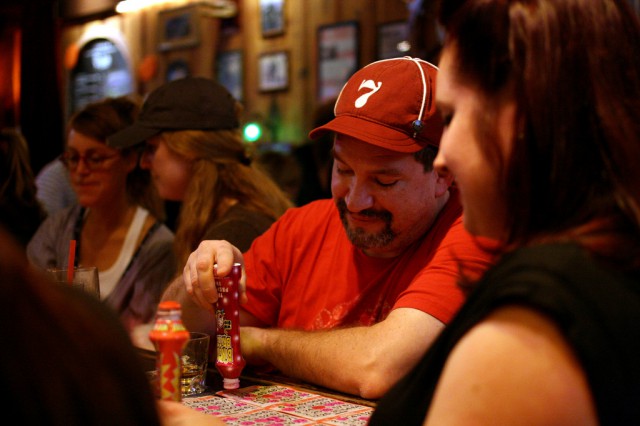
Written by Bek Phillips
The door clangs shut behind me and a guard behind a window asks for identification. The buzzer sounds as a second door opens and I take my first steps behind the walls, into San Quentin.
But the inside looks nothing like televised prisons.
Tall palm trees, luscious gardens, and a large stonework fountain are reminiscent of ritzy country clubs. Today the atmosphere is completely transformed as sounds of laughter, children’s voices, and a year’s worth of stories permeate the air.
Today is Family Day—a chance for the workers of San Quentin to bring family and guests to explore the world that they encounter day-in and day-out.
As families gather outside the prison walls, children linger close to their parents. A middle-school-aged boy looks like he is about to burst with excitement, but his father’s hand rests protectively on his back as he tells his son stories and gets him ready for the tour. To bring your child into the prison, they must be at least twelve years old. This is his first time visiting and I hear him excitedly tell his sister that he cannot wait to see the gas chamber.
For many people, “bring your child to work” day tends to be centered around the office. Wide-eyed children play on the floor while their parents are typing up reports or busy with other official business. They get led around and bragged about to all the other employees. But for San Quentin, Family Day is a day of celebration as well as giving family members the chance to experience what their loved ones go through on a day-to-day basis.
Fernando Palazio, 25, is also here for the first time. His aunt, Evelyn Rizzo, works as a nurse’s assistant with level three security clearance. Tall with dark curly hair and the shading of a beard, Fernando has an infectious smile and a tendency to speak his mind.
He has heard his aunt tell numerous stories, ranging from the history of the three-wall Diego Rivera mural in the dining hall to the story about an inmate who is renowned for swallowing razor blades and who, at one time, was unable to have one surgically removed and had to pass the blade naturally. But now inside for the first time, he struggles with his expectations and the reality he is surrounded by.
“It’s like it’s a movie,” he murmurs.
The dichotomy between the reality of prison life and the appearance from outside the cells is astounding, a feeling of dual realities clouding the mind. Even as I stand in a beautiful courtyard, the conversations of the tour guards fill the air with despair as they recount the deaths that had occurred right where we were standing.
Talks of prisoners in the Adjustment Center, where the most loathsome and dangerous condemned prisoners are held bring alive images of them flinging their feces in the guards face, doing everything they could to spite the ones that kept them from freedom. Now, the cells in the Adjustment Center have been remodeled for the protection of the guards, everything has changed—down to the underwear the men wear—no elastic.
At San Quentin there are one-thousand four-hundred-eight employees, one-thousand two-hundred seventy-two who work in non-medical fields. The total inmate population totals four-thousand two hundred fifty-nine, with seven-hundred twenty-two of those living in Death Row. San Quentin is the only prison with a Death Row in California.
The levels of security for a prison are ranked one through four, and maximum security. At this time, there are no level four inmates housed. It’s mainline is level one and two. This means that without Death Row, San Quentin would not be considered a maximum security prison.
Outside, the party atmosphere is complete with a vendor, free t-shirts, burgers, hotdogs, chips, soda—everything you would expect for a perfect barbecue. The prisoners are shuttled back into their cells early so the families have the freedom to explore every aspect of their lives.
The lone vendor selling bundt cakes stands out amidst the festivities “Nothing Bundt Cakes”—the name itself a play on words. But it is more than that. The idea of turning a profit from selling to the families of workers, the prisoners themselves an attraction, leaves a bad taste in the mouth. Soon though the sounds of barking dogs, rehabilitated by the inmates, and the sound of laughter as gaggles of teenage girls walk by, bring me back to the festivities.
But despite the open, beautiful outdoors, the oppressive nature of life in San Quentin could not be escaped so easily.
The walls making up the outdoor corridors to fields and exercise areas are lined with barbed wire, some collapsible so as to entangle any escapee who tries to maneuver through the weighted snares.
A mural painted in bright colors with hands cradling a world says “we are the curators or life, we hold it in the palms of our hands,” but close by on ancient iron doors the word “terror” is etched with the year “1950”.
Other stark contrasts are the work spaces compared to leisure or study space. The work room for carpentry, displaying a sign forbidding hobby work, is spacious. It spans the entire floor of a large factory-size building with different areas for carpentry, sewing, chair making, and other such projects. Despite the sign forbidding personal craft, little bits of personality can be found scattered in the form of chair covers with favorite football teams or projects made for the guards.
Conversely, the library, art and music rooms are tiny. The art and music room, with well worn furnishing that looks past its prime and in need of replacing, could be the same size of an average teenager’s bedroom. The library, a diminished small building has about six shelves filled with books and a wall lined with four computers.
The librarian, a friendly elderly gentleman, explains in his soft voice that most prisoners come here for legal work, and to read crime novels, Ann Rule a favorite author.
Despite the small rooms, the creativity displayed by inmates is breathtaking. Expansive and detailed artwork lines the walls of the art room. One spirited female guard, who has worked in San Quentin for six years, explains to wandering tour groups that the inmates operate their own print shop as well, putting out calendars and newspapers, a practice in danger now that the overseer is retiring. For her, the art and music room is refreshing. In a place where everything is highly structured and tightly scheduled, it provides a break in monotony.
“The environment dictates a lot,” she says. “Here it is a brand new place every day, you never know what you are going to walk into.”
The inmates are allowed a break when they play their weekly baseball games. Over the field the sign reads “San Quentin A’s” in large green sprawling letters, underneath in smaller letters the “San Quentin Giants”. I find myself grinning, thinking “Go A’s!” Looking over the field the mountain and trees are black against the sunset, a scattering of clouds causing the brilliant colors to stand out. A family of twenty to thirty geese live on the field during the off days, guard dogs implemented when it is time to play.
But the openness of the outdoors can be deceiving. Walking into the dining room, the Diego Rivera wall mural—one of three—spans the length of the room. The image depicts life on a ship, temporarily docked, with people bustling about, the image itself teeming with life. The artistry creates an illusion that no matter where you are, you are in the center, the boat following you. But what follows the inmates are rules, guards, and structure.
Even Fernando cannot escape from the overwhelming feeling of structured confinement.
“The social places, where they eat, it was almost like they’ll give you such a small small window to feel free. The whole point is that you’re an inmate and everything else is big except for where these people can express themselves or learn,” he says.
Outside, the food is still being served. Dogs, sick or misbehaved that have been sufficiently trained and attended to by inmates, are displayed for adoption in mini cages made up of chicken wire. And for the first time ever, a simulated hostage demonstration by the warden’s office was being held by the Specialized Emergency Team.
Inside, the tour goes on. The open light air of the bay is being left further and further behind and the darker side of San Quentin continues to emerge. In General Population, where the majority of prisoners are housed, four inmates have allowed for their cells to be put on display for the families of those who police and monitor them.
The cells are stacked five stories high, the rows seemingly endless. The air immediately gets thicker and waves of claustrophobia come crashing down.
Women wearing close to nothing and posing provocatively are in images that cover the walls. A small shelf on the wall by the toilet are only places for personal belonging. On one shelf are bottles of vitamins. Bunk beds fill the majority of the room, the walls close enough to touch with outreached arms. Not even enough room to do push-ups.
Walking down the hallway, I suddenly feel that eyes are peering back at me as I strain my vision, looking into the darkened cells. Embarrassed, I avert my eyes, trying not to see. As I keep walking I can feel the stares. One cell opening is covered in a sheet, a silhouette of a man reading filling the small space. The next cell holds in it a middle-aged black man, sprawled across the bed, earphones blasting music as he drowns out the noise of people passing by.
“Afternoon ma’am,” one inmate says. “How is your day going?” He is standing by the barred door, his eyes kind and hair graying.
Before the conversation can go further, a female guard quickly cuts in calling out “No talking inmate,” as she walks towards me explaining that communication is highly discouraged.
“Oh, no, don’t pet the rhino,” Palazio says close by. “They are treating the event like its a day in the zoo, look but don’t touch. And don’t talk.”
Family day. A day where all can see a friendly facade of prison life—the art, the baseball field, the tennis courts, the jobs in the factory—and yet the reality is lurking in the shadows, reflected in the eyes that stare back for only a moment before shifting away, and back into the darkness.
One guard who oversees inmates in the furniture factory, respects not only the inmate’s craftsmanship but the person’s as well. His voice gets excited and his eyes shine as he talks about them and their craftsmanship.
But, as he tells it, family day is hard for the prisoners with early curfews, and families parading their friends and children by. He would like the people to see the inmates as he sees them the other three-hundred-sixty-four days he is here. “On days like this, the inmates feel disrespected,” he says.
“I know a lot of the guys, a lot of them are really smart, smarter than me. They just made a mistake, and it’s behind them. They are people and they can make just about anything in here.”
Lt. Sam Robinson has been at San Quentin for seventeen years, and thinks that focusing on the inmates takes away from what family day is all about. He believes that the focus should be on the families and giving them an opportunity to connect their loved ones with a job everyone considers essential.
“It is a mechanism to boost moral, you share the stories with loved ones, it’s a win-win to see the challenges that go on and how they overcome them,” Robinson says.
As far as the affects it has on the inmates, Robinson is convinced that there are no hard feelings.
“Prisoners take it two ways. Some would prefer to be outside, but you are not disconnected from the prisons. The event brings humanity in that they are sharing the loved ones with them, saying we trust you enough to bring the people we love most around you,” he says.
But no matter the justification, it is all about family to him.
The people I work with are my family and the people they are bringing are extended family, your sisters and nieces. You hear stories about them all year long and it is a chance to see them.”
Overall, he maintains that the event is “perfect as it is.”
The tour is winding down, the mountains are black against the setting sun, and with a final glance at a Diego Rivera mural in the dining hall, I start to take the final steps back out to freedom.
A single room remains on the prison side of the gates with a sign that reads “Parole Hearing.” I stare turning my head as the first heavy door clangs shut behind me. I wonder how many times inmates stared at the double gates. The idea of freedom so tangible, the outside world not even forty feet away.
But as I leave the prison behind me, there is one last place to visit, the air now crisp and chilly with nightfall.
The gas chamber. Painted in a bright green, the octangular room instantly stands out. Two chairs with straps dominate the space. Since 1937, dozens have sat in a similar room. This one is brand new. Currently there are more than twelve people waiting for execution, all their appeals have run dry. The soonest execution could be next year.
“Please keep arms and legs inside at all times,” someone jokes. “It’s gonna be a bumpy ride.”




